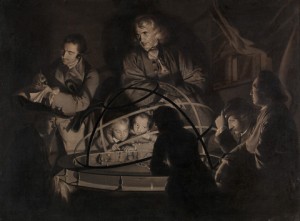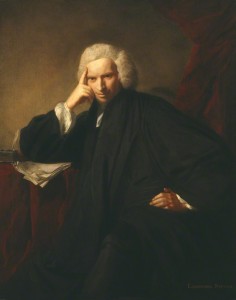
Joseph Wright of Derby, Philosopher Giving a Lecture on the Orrery. ca. 1768. Oil on canvas. 17 5/8 x 23 1/2 inches (44.8 x 59.7 cm). Yale Center for British Art, Paul Mellon Collection.
Have you ever wanted to look through Galileo’s telescope, compare Hooke’s illustrations in Micrographia to the specimens he depicted, or turn through the pages of Diderot’s Encyclopédie with your own hands? Or to see a first edition of Vesalius’ On the Fabric of the Human Body, Descartes’ Discourse on Method, and Franklin’s Experiments and Observations on Electricity, preferably without having to travel from library to library? Within the Huntington Library’s exhibition, Beautiful Science: Ideas that Changed the World, these and many more objects are on view and clamor for your attention. Opening in 2008, the exhibition is beautifully in tune with the recent resurgent interest in Enlightenment and Romantic science, most notably with the success of Richard Holmes’ The Age of Wonder. I recently visited Beautiful Science for a tour with its curator, Daniel Lewis, as a student of the California Rare Book School. I later interviewed Lewis about the curatorial choices facing him in developing Beautiful Science and his goals for the exhibition. Below is an edited version of our emailed conversation.
Beautiful Science grew out of an enormous donation of the “Burndy Library,” 67,000 volumes of books and manuscripts from the Dibner family, which then drove you back to the Huntington’s own history of science collection. What was the shape of that collection?
The Huntington’s history of science collections, as they existed before the arrival of the Burndy, were substantial. A small handful of items were on display in the “New Worlds” section of the Main Library Exhibit Hall, but there was nothing like a public history of science exhibit presence before the arrival of the Burndy collection from the Dibner family. Enlightenment science, however, was certainly of great interest in the research side of things at the Huntington. We are one of the world’s great repositories for early modern British history, and the history of science, medicine and technology has been an important aspect of scholarly investigations for at least a quarter-century.
There’s a real emphasis in the exhibition on engaging the senses – visitors are invited to look through replica microscopes, reenact experiments with light, and open stoppers to sniff medicinal herbs. Was there something about the material you were displaying that invited this particular approach? Was there any resistance to it?
I wanted very much to find a way for visitors to engage in a very low-level tactile fashion with the exhibit — what I call “interactive light.” I didn’t want people to misunderstand the exhibit to be a science center. There’s nothing for people to jump up and down on; nothing to throw or no mild electrical shocks to receive. It’s a library exhibit, above all else, and almost everything in the exhibit is designed to reinforce this. But that doesn’t mean we didn’t want to engage people with the olfactory, the tactile, and the experiential.
Speaking of the exhibit’s tactile quality, you have on display an original volume of Diderot’s Encyclopédie, which visitors can sit down and page through at their leisure – a truly rare event! How in the world did that happen?
One of the most common requests I get when doing show-and-tells for visitors and potential donors, is, “Can I touch that?” The answer is usually no — but I wanted people in an exhibit setting to understand what old paper felt like — its long fibers, its soft, pliable nature, its smell, and any other characteristic that people wanted to investigate (non-destructively!). So I located an eighteenth century work — old enough to be made from old cotton rags, rather than more modern wood-pulp paper — that was very common. Diderot’s Encyclopédie was printed in large numbers, and we have three pristine sets — and I thought it an appropriate use for the work to be put on public display.
Do you see Beautiful Science as intervening, or taking a stand, in any particular curatorial or pedagogical disputes? What do you think the public duty of an institution like the Huntington ought to be in the communication or preservation of ideas?
In some ways, Beautiful Science is a love letter to beauty and science. It doesn’t particularly critique the very numerous things that science has not done well, or scientific knowledge that has been submerged for various reasons, nor does it make comment on, say, the horrors of modern warfare that science has made possible. But that kind of critique wasn’t my goal for the exhibit. The goal really was to show the different ways that science could be beautiful, simply put. I think if I took any obvious pedagogical stance, it’s that there’s an immediacy to original library materials that can’t be replaced by the digital or the analog facsimile, and that to be in the presence of books is to see the power of big ideas that can be widely distributed over space and time.
You mentioned during my visit that an exhibition catalogue is in the works. What particular considerations does the catalogue require?
I’ve been creating the catalog as a superset of the exhibit — it has the same major themes and subthemes, but I’ve stretched my legs a bit to show other items in the catalog for which there was no physical room in the brick-and-mortar exhibit. The catalog will also contain considerably more text. Books are different creatures than exhibits, as there are no time constraints on a “visit” to a printed catalog in the way there usually are in an exhibit setting.
The exhibition’s rooms each have their own theme: astronomy, light, medicine, and natural history. If you were to add a fifth room, what area would you pick? Are there some alchemy and chemistry holdings in the wings?
I’d have a room full of dusty computers. NOT! I suppose I’d like to have a section on civil and military engineering — both great strengths of ours. Applied science is a beautiful thing.
It struck me when I visited that Beautiful Science was remarkably accessible – that it would be equally appealing to school kids, folks seeking shade while wandering the Huntington grounds, and eighteenth-century enthusiasts. How did you go about striking a balance?
I stared at my computer screen until beads of blood appeared on my forehead. Writing label text that’s sufficiently brief, not overly self-involved or navel-gazing, accurate, accessible, and reasonably eloquent is a very difficult task. I’m probably most proud of the text in the exhibit; I conceived and wrote it all myself.
What would you say is the importance of remembering the outmoded ideas on display — the models of the universe we know are incorrect, the animals we know don’t exist (I’m looking at you, manticore)?
I think those things reinforce an idea that I make explicit on my title wall text as you walk into the exhibit: that we’re on an unknown arc into the future, and that our ideas about the physical world are likely to change, be stood on their head, and then change again.
Are there any particular items that the eighteenth century enthusiasts should be on the lookout for?
Sure, plenty. I suppose my favorites are the early notions of transmutation or fixity of species — the concept that we live in an evolving natural world was actually more widely considered than people give early natural philosophers credit for. But you do have to reach further back before that period to get a more modern view, ironically.
A silly question, but if you were to choose a single favorite historical item on display, what would it be?
That’s a tough one, akin to “which of your children do you love the best?” Three leading candidates: Gersdorff’s 1517 Fieldbook of Wound Surgery¸for its dramatic and bloody renderings of medical assistance; or Darwin’s 1859 On the Origin of Species, for its world-changing views of nature; or the early nineteenth century French natural history manuscript — untitled — by a trio of French illustrators about whom very little is known. The illustrations are absolutely breathtaking.
Daniel Lewis is the Chief Curator of Manuscripts and the Dibner Senior Curator of the History of Science and Technology, at the Huntington Library in San Marino, California. He is also a Research Associate Professor of History at Claremont Graduate University and a faculty member at the California Rare Book School.
Further Reading:
Benedict, Barbara. Curiosity: A Cultural History of Early Modern Inquiry. Chicago: University of Chicago Press, 2002.
Blom, Philipp. Enlightening the World: Encyclopedia, The Book That Changed the Course of History. New York: Palgrave Macmillan, 2005.
Dolnick, Edward. The Clockwork Universe: Isaac Newton, the Royal Society, and the Birth of the Modern World. New York: Harper Collins, 2011.
Dugatkin, Lee Alan. Mr. Jefferson and the Giant Moose: Natural History in Early America. Chicago: University of Chicago Press, 2009.
Hamblyn, Richard. The Invention of Clouds: How an Amateur Meteorologist Forged the Language of the Skies. New York: Picador, 2001.
Holmes, Richard. The Age of Wonder. New York: Vintage Books, 2008.
Hoskin, Michael. Discoverers of the Universe: William and Caroline Herschel. Princeton: Princeton University Press, 2011.
Jardine, Lisa. Ingenious Pursuits: Building the Scientific Revolution. New York: Random House, 1999.
Moore, Wendy. The Knife Man: Blood, Body Snatching, and the Birth of Modern Surgery. New York: Broadway Books, 2005.
Porter, Roy. The Greatest Benefit to Mankind: A Medical History of Humanity. New York: Norton Books, 1999.
Ridley, Glynis. The Discovery of Jeanne Baret: A Story of Science, the High Seas, and the First Woman to Circumnavigate the Globe. New York: Random House, 2010.
Shank, J.B. The Newton Wars and the Beginning of the French Enlightenment. Chicago: University of Chicago Press, 2008.
Shapin, Steven and Simon Schaffer. Leviathan and the Air-Pump: Hobbes, Boyle, and the Experimental Life. Princeton: Princeton University Press, 2011 [1985].
Stalnaker, Joanna. The Unfinished Enlightenment: Description in the Age of the Encyclopedia. Ithaca: Cornell University Press, 2010.
Stott, Rebecca. Darwin’s Ghosts: The Secret History of Evolution. New York: Spiegel and Grau, 2012.
Withers, Charles W.J. Placing the Enlightenment: Thinking Geographically about the Age of Reason. Chicago: University of Chicago Press, 2007.
























